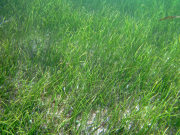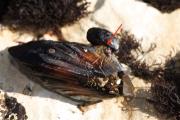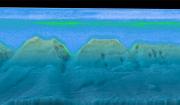Radio Program
Our regular Science and the SeaTM radio program presents marine science topics in an engaging two-minute story format. Our script writers gather ideas for the radio program from the University of Texas Marine Science Institute's researchers and from our very popular college class, Introduction to Oceanography, which we teach to hundreds of non-science majors at The University of Texas at Austin every year. Our radio programs are distributed at to commercial and public radio stations across the country.
The classic example of chaos theory is called the butterfly effect: If a butterfly flaps its wings over China, it creates ripples in the air that might eventually trigger storms over the Americas. Something similar may be playing out over the South China Sea and the surrounding land: Changes in climate conditions there may influence the rest of the world.
If you’re afraid of the dark, you should avoid the “midnight zone” in the oceans. It’s so far down that no sunlight ever reaches it. The zone’s inhabitants include creatures with bulging eyes and big, sharp teeth, and some with bright, wiggling “lures” to attract prey.
One inhabitant also looks like the stuff of nightmares, but it’s a threat only to small fish and other tiny creatures: Stygiomedusa gigantea—the giant phantom jelly. Its “body”—known as a bell—is about three feet across. It can expand to several times that size, though, perhaps to wrap up its prey.
In a classic Jules Verne novel, the submarine Nautilus travels “20,000 leagues under the sea.” You might think that “20,000 leagues” indicated the sub’s depth. But you’d need a really deep ocean for that: a league is three miles, so 20,000 leagues is 60,000 miles. The title tells us how far the Nautilus traveled through the oceans.
Over the centuries, sailors and mapmakers created new units of measure, with new words to describe them, for plying the world’s oceans. Some of the words have been heaved overboard, but some are still in use.
The telescopefish has a cast-iron stomach. Not only can the stomach digest prey that’s bigger than the telescopefish itself, but it’s as dark as cast iron. That prevents the fish’s prey from getting revenge by attracting critters that might eat the telescopefish.
There are two known species of telescopefish. Members of both species are small—no more than about six to eight inches long. They’re found in fairly warm waters around the world, at depths of a third of a mile to a mile and a half or so.
From poetry to music to movies, we’re always hearing about the “deep blue sea.” But the seas aren’t always deep blue. And sometimes, they’re not blue at all. They can be green, brown, or other colors. And each color can tell us something about what’s happening in that part of the sea.
Understanding what the colors are telling us is one goal of PACE—Plankton, Aerosol, Cloud, Ocean Ecosystem—a NASA satellite that launched in February.
For the seagrass beds of southern Texas, rising sea level may be a case of give and take—or make that take and give. Higher waters are killing off some seagrass. But as the water rises even higher, newly submerged land has the potential to increase the total seagrass area.
Seagrass is important for many coastal ecosystems. It can protect the coast from storms, filter pollution from runoff, and provide habitat and food for fish and other life. So losing seagrass is a big deal.
The “beards” of marine mussels aren’t just a fashion statement. They anchor the mussels to the sea floor, attach to each other to form large “beds,” and hold out potential invaders. They’re also playing a role in materials research—scientists study the beards to learn how to make water-proof glue for many applications.
The beards consist of a bundle of about 20 to 60 threads known as a byssus. The threads radiate outward from the mussel’s “foot.” Each thread is tipped with a biological superglue—a combination of proteins from the mussel and metals from the water.
Early in World War II, the Navy began using sonar to probe for enemy U-boats. Ships would send out pulses of sound, then measure their reflection to figure out what was below. But early observations revealed something a little disconcerting: The ocean floor wasn’t where it was supposed to be—it was a lot closer to the surface. Sonar operators thought they might be seeing uncharted underwater islands.
Pufferfish in Japan are known for one thing. They’re a delicacy that can be deadly. Their organs contain a highly toxic compound that can kill in minutes. But one species of pufferfish has a different distinction: Its males might be the most creative artists in the oceans.
In 1995, divers off the coast of Japan saw an unusual pattern in the sand on the ocean floor—a circle with small peaks and valleys radiating out from a flat center. It wasn’t until 2011 that marine scientists could explain them: the creations of a species known today as white-spotted pufferfish.
As Earth gets warmer, scientists expect to see some changes in hurricanes. There might not be more of them, but the strongest ones might be much more intense.
To better understand what might happen, scientists are digging deep into the past. They’re looking at how often especially powerful hurricanes made landfall when climate conditions were similar to what we’re seeing today.












